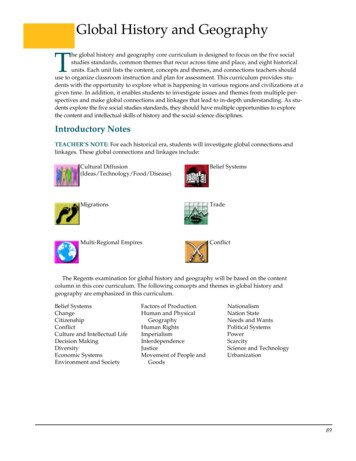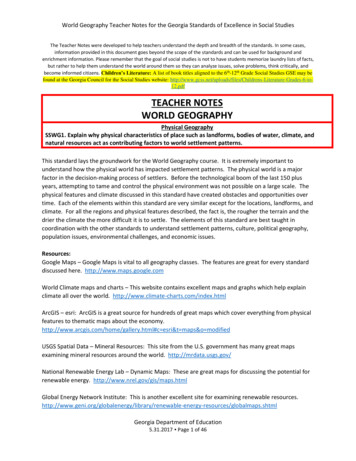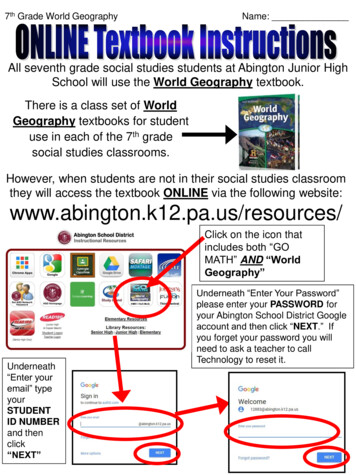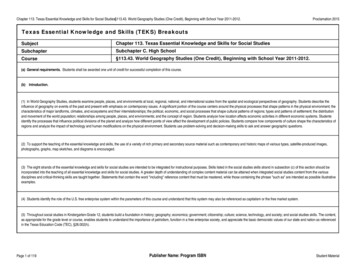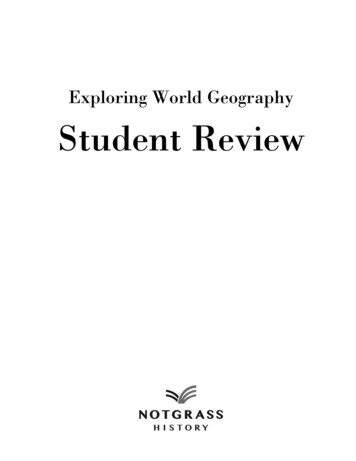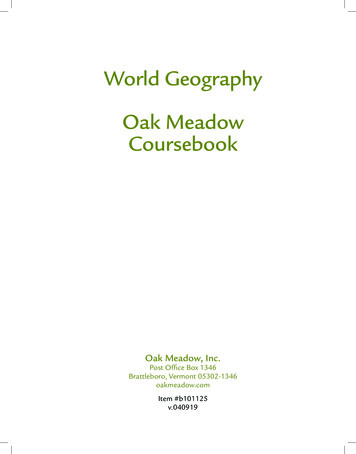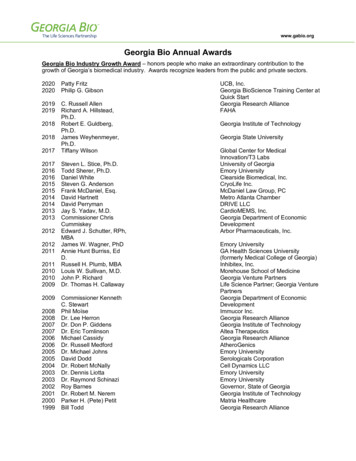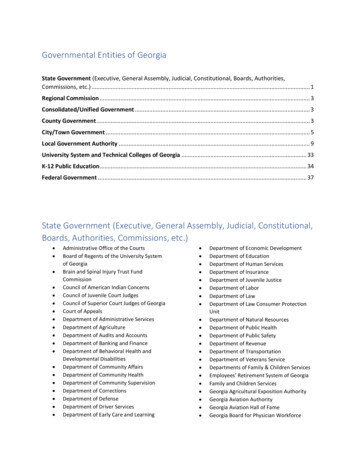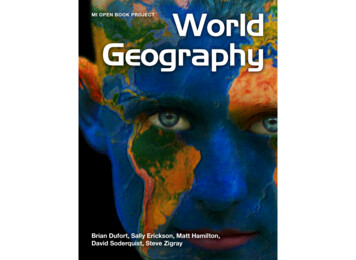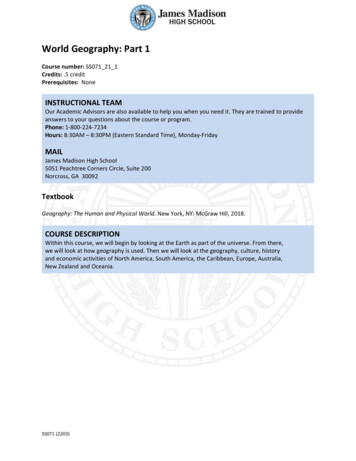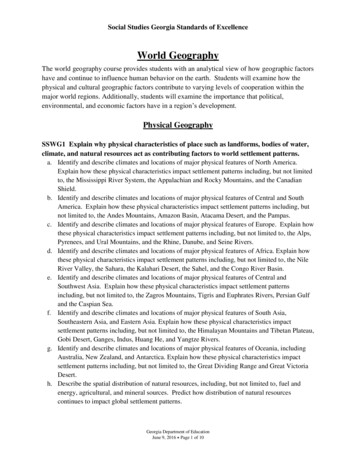
Transcription
Social Studies Georgia Standards of ExcellenceWorld GeographyThe world geography course provides students with an analytical view of how geographic factorshave and continue to influence human behavior on the earth. Students will examine how thephysical and cultural geographic factors contribute to varying levels of cooperation within themajor world regions. Additionally, students will examine the importance that political,environmental, and economic factors have in a region’s development.Physical GeographySSWG1 Explain why physical characteristics of place such as landforms, bodies of water,climate, and natural resources act as contributing factors to world settlement patterns.a. Identify and describe climates and locations of major physical features of North America.Explain how these physical characteristics impact settlement patterns including, but not limitedto, the Mississippi River System, the Appalachian and Rocky Mountains, and the CanadianShield.b. Identify and describe climates and locations of major physical features of Central and SouthAmerica. Explain how these physical characteristics impact settlement patterns including, butnot limited to, the Andes Mountains, Amazon Basin, Atacama Desert, and the Pampas.c. Identify and describe climates and locations of major physical features of Europe. Explain howthese physical characteristics impact settlement patterns including, but not limited to, the Alps,Pyrenees, and Ural Mountains, and the Rhine, Danube, and Seine Rivers.d. Identify and describe climates and locations of major physical features of Africa. Explain howthese physical characteristics impact settlement patterns including, but not limited to, the NileRiver Valley, the Sahara, the Kalahari Desert, the Sahel, and the Congo River Basin.e. Identify and describe climates and locations of major physical features of Central andSouthwest Asia. Explain how these physical characteristics impact settlement patternsincluding, but not limited to, the Zagros Mountains, Tigris and Euphrates Rivers, Persian Gulfand the Caspian Sea.f. Identify and describe climates and locations of major physical features of South Asia,Southeastern Asia, and Eastern Asia. Explain how these physical characteristics impactsettlement patterns including, but not limited to, the Himalayan Mountains and Tibetan Plateau,Gobi Desert, Ganges, Indus, Huang He, and Yangtze Rivers.g. Identify and describe climates and locations of major physical features of Oceania, includingAustralia, New Zealand, and Antarctica. Explain how these physical characteristics impactsettlement patterns including, but not limited to, the Great Dividing Range and Great VictoriaDesert.h. Describe the spatial distribution of natural resources, including, but not limited to, fuel andenergy, agricultural, and mineral sources. Predict how distribution of natural resourcescontinues to impact global settlement patterns.Georgia Department of EducationJune 9, 2016 Page 1 of 10
Social Studies Georgia Standards of ExcellenceCultural GeographySSWG2 Evaluate how the physical and human characteristics of places and regions areconnected to human identities and cultures.a. Examine how ethnic compositions of various groups has led to diversified culturallandscapes, including, but not limited to, architecture, traditions, food, art, and music.b. Examine how language can be central to identity and a unifying or a divisive force (e.g.,Bantu, French-Canadians (Quebecois), and Basques.c. Examine the effects of universalizing and ethnic religions on local populations, including,but not limited to, Christianity, Judaism, Islam, Hinduism and Buddhism.d. Examine the impact of cultural beliefs on gender roles and perceptions of race and ethnicityas they vary from one region to another (e.g., the caste system, apartheid, and legal rightsfor women).e. Explain the processes of culture diffusion and convergence through the effects of variousmedia norms, transnational corporations, and technological advancements in transportationinfrastructure (e.g., Coca-Cola and American fast food restaurants, social media networks,and universalized clothing choices).Political GeographySSWG3 Evaluate how cooperation and conflict among people influence the division andcontrol of the earth’s surface.a. Explain why political boundaries are created and why they change (e.g., nation, state vs.nation-state; political vs. ethnic sovereignty; the unrecognized states of Palestine, Kosovo,and Taiwan).b. Explain how geography (size, shape, and relative location) can be an advantage ordisadvantage to participation in global exchange (e.g., Chile, Indonesia, Russia, Canada,South Africa/Lesotho, Turkey, and Switzerland).c. Explain the causes of external and internal conflicts among cultural groups, including butnot limited to ongoing border disputes and separatist movements (e.g., partition of India,post-colonial Africa, and independence movements of the Scots, Kurds, and Basques).d. Explain how political, economic, and social networks and organizations of global powerinfluence places, countries, and regions (e.g., United Nations, NAFTA, African Union, theEuropean Union, the Association of Southeast Asian Nations, 1961 Antarctica Treaty,Non-Governmental Organizations, and social media).Georgia Department of EducationJune 9, 2016 Page 2 of 10
Social Studies Georgia Standards of ExcellencePopulation GeographySSWG4 Assess the characteristics, spatial distribution, and migration of humanpopulations on the earth’s surface.a. Assess demographic patterns of population using graphs, maps, and other models (e.g.,Demographic Transition Model, population density maps, and global migration patterns).b. Analyze population issues in reference to pro and anti-natal policies of different countriesand their effects on population characteristics (e.g., China’s natalist policy,maternity/paternity leave policies, and child subsidies).c. Explain how push and pull factors contribute to human migration patterns and evaluate theimpact of migration on the use of resources and provision of services (e.g., guest workers,refugees, and evacuees).d. Compare the response of different groups and governments to migration, including nationalmigration policies and differing responses by local communities (e.g., quotas, amnesty,resettlement programs, and official language laws).Environmental GeographySSWG5 Analyze human interactions with the world’s environments.a. Describe how and why agricultural techniques and technology have changed over time(e.g., irrigation, crop rotation, green revolution, and GMO’s).b. Analyze the impact of water insecurity around the world (e.g., drought, desertification,water rights, and depletion of the Aral Sea).c. Analyze the economic, political and environmental impacts associated withindustrialization and natural resource management around the world (e.g., fracking, stripmining, building of dams and reservoirs, deforestation, sustainable development, andrenewable vs. non renewable resources).d. Analyze international and varied local governmental responses to natural disasters incountries around the world (e.g., hurricanes, earthquakes, and tsunamis).e. Evaluate how global trade systems impact environmental sustainability in both importingand exporting countries (e.g., plantation farming in Africa and Central/South America,overfishing of global waterways, and international lumber trade).Georgia Department of EducationJune 9, 2016 Page 3 of 10
Social Studies Georgia Standards of ExcellenceEconomic GeographySSWG6 Examine the spatial distribution of major economic systems and analyze the rolegeography plays in economic development.a. Compare the levels of economic development of countries in terms of Gross DomesticProduct (GDP) per capita and key demographic and social indicators (e.g., literacy rate, lifeexpectancy, gender, access to healthcare, and UN Sustainable Development Goals for2030).b. Explain the relationship between levels of development and economic activity in terms ofprimary, secondary, and tertiary activities (e.g., resource extraction, manufacturing, andservices).c. Describe the factors that influence the location and spatial distribution of economicactivities, including the factors of site and situation (e.g., river systems, transportation hubs,research triangles, deep seaports).d. Describe and explain causes and consequences of the worldwide trend towardsurbanization in terms of development (e.g., changing employment patterns, urban sprawl,squatter settlements, and gentrification).e. Analyze the impact of trade across international borders and its impact on governmentrelationships among countries (e.g., legal trade: NAFTA, EU, and OPEC; illegal trade:human trafficking, drug trade, and counterfeiting/black market goods).Georgia Department of EducationJune 9, 2016 Page 4 of 10
Social Studies Georgia Standards of ExcellenceMap and Globe SkillsGOAL: The student will use maps to retrieve social studies information.I: indicates when a skill is introduced in the standards and elements as part of the contentD: indicates grade levels where the teacher must develop that skill using the appropriate contentM: indicates grade level by which student should achieve mastery, the ability to use the skill inall situationsA: indicates grade levels where students will continue to apply and improve mastered skillsMap and Globe Skills1.use a compass rose to identify cardinaldirections2.use intermediate directionsK1234567IM AAAAAA AAM AAAAA AAIMAAAA AAIMAAAA AAIM AA AAI3.use a letter/number grid system to determinelocation4. compare and contrast the categories ofnatural, cultural, and political features foundon maps5. use graphic scales to determine distances ona map6. use map key/legend to acquire informationfrom historical, physical, political, resource,product, and economic maps7. use a map to explain impact of geography onhistorical and current events8. draw conclusions and make generalizationsbased on information from maps9. use latitude and longitude to determinelocation10. compare maps of the same place at differentpoints in time and from differentperspectives to determine changes, identifytrends, and generalize about human activities11. compare maps with data sets (charts, tables,graphs) and /or readings to draw conclusionsand make generalizations12. use geographic technology and software todetermine changes, identify trends, andgeneralize about human activitiesIGeorgia Department of EducationJune 9, 2016 Page 5 of 1089-12ID MAAA AADD MAAA AAIMAAA AAIDDD M AAIM AA AAIM AA AAI
Social Studies Georgia Standards of ExcellenceInformation Processing SkillsGOAL: The student will be able to locate, analyze, and synthesize information related to socialstudies topics and apply this information to solve problems/make decisions.I: indicates when a skill is introduced in the standards and elements as part of the contentD: indicates grade levels where the teacher must develop that skill using the appropriate contentM: indicates grade level by which student should achieve mastery, the ability to use the skill inall situationsA: indicates grade levels where students will continue to apply and improve mastered skillsInformation Processing SkillsK13456789-121.compare similarities and differencesID M AAAAAAA2.organize items chronologicallyIDD MAAAAAA3.identify issues and/or problems andalternative solutionsIDDD M AAAA4.distinguish between fact and opinionID MAAAAAA5.identify main idea, detail, sequence ofevents, and cause and effect in a socialstudies contextidentify and use primary and nterpret timelines, charts, and tables8.identify social studies reference resources touse for a specific purposeIMAAAAAA9.construct charts and tablesIMAAAAAAIDD M AAAA11 draw conclusions and make generalizationsIMAAAA12. analyze graphs and diagramsID M AAAA13. translate dates into centuries, eras, or agesID M AAAA14. formulate appropriate research questionsIM AAAA15. determine adequacy and/or relevancy ofinformationIM AAAA16. check for consistency of informationIM AAAA17. interpret political cartoonsIDD MA10. analyze artifactsGeorgia Department of EducationJune 9, 2016 Page 6 of 10AD
Social Studies Georgia Standards of ExcellenceClarification for Literacy Standards in High School:Grades 9-10 social studies courses incorporate the grades 9-10 Reading/Writing Standards forLiteracy in History/Social Studies.Grades 11-12 social studies courses incorporate the grades 11-12 Reading/Writing Standards forLiteracy in History/Social Studies.READING STANDARDS FOR LITERACY IN HISTORY/SOCIAL STUDIES (RHSS) GRADE 9-10 Key Ideas and DetailsL9-10RHSS1: Cite specific textual evidence to support analysis of primary and secondary sources, attending to suchfeatures as the date and origin of the information.L9-10RHSS2: Determine the central ideas or information of a primary or secondary source; provide an accuratesummary of how key events or ideas develop over the course of the text.L9-10RHSS3: Analyze in detail a series of events described in a text; determine whether earlier events caused laterones or simply preceded them. Craft and StructureL9-10RHSS4: Determine the meaning of words and phrases as they are used in a text, including vocabulary describingpolitical, social, or economic aspects of history/social science.L9-10RHSS5: Analyze how a text uses structure to emphasize key points or advance an explanation or analysisL9-10RHSS6: Compare the point of view of two or more authors for how they treat the same or similar topics,including which details they include and emphasize in their respective accounts. Integration of Knowledge and IdeasL9-10RHSS7: Integrate quantitative or technical analysis (e.g., charts, research data) with qualitative analysis in printor digital text.L9-10RHSS8: Assess the extent to which the reasoning and evidence in a text support the author’s claims.L9-10RHSS9: Compare and contrast treatments of the same topic in several primary and secondary sources. Range of Reading and Level of Text ComplexityL9-10RHSS10: By the end of grade 10, read and comprehend history/social studies texts in the grades 9–10 textcomplexity band independently and proficiently.*This document continues on the next page with writing standardsGeorgia Department of EducationJune 9, 2016 Page 7 of 10
Social Studies Georgia Standards of ExcellenceWRITING STANDARDS FOR LITERACY IN HISTORY/SOCIAL STUDIES, SCIENCE, ANDTECHNICAL SUBJECTS GRADES 9-10 (WHST) Text Types and PurposesL9-10WHST1: Write arguments focused on discipline-specific content.a. Introduce precise claim(s), distinguish the claim(s) from alternate or opposing claims, and create an organization thatestablishes clear relationships among the claim(s), counterclaims, reasons, and evidence.b. Develop claim(s) and counterclaims fairly, supplying data and evidence for each while pointing out the strengths andlimitations of both claim(s) and counterclaims in a discipline-appropriate form and in a manner that anticipates theaudience’s knowledge level and concerns.c. Use words, phrases, and clauses to link the major sections of the text, create cohesion, and clarify the relationshipsbetween claim(s) and reasons, between reasons and evidence, and between claim(s) and counterclaims.d. Establish and maintain a formal style and objective tone while attending to the norms and conventions of the discipline inwhich they are writing.e. Provide a concluding statement or section that follows from or supports the argument presented.L9-10WHST2: Write informative/explanatory texts, including the narration of historical events, scientific procedures/experiments, or technical processes.a. Introduce a topic and organize ideas, concepts, and information to make important connections and distinctions; includeformatting (e.g., headings), graphics (e.g., figures, tables), and multimedia when useful to aiding comprehension.b. Develop the topic with well-chosen, relevant, and sufficient facts, extended definitions, concrete details, quotations, orother information and examples appropriate to the audience’s knowledge of the topic.c. Use varied transitions and sentence structures to link the major sections of the text, create cohesion, and clarify therelationships among ideas and concepts.d. Use precise language and domain-specific vocabulary to manage the complexity of the topic and convey a styleappropriate to the discipline and context as well as to the expertise of likely readers.e. Establish and maintain a formal style and objective tone while attending to the norms and conventions of the discipline inwhich they are writing.f. Provide a concluding statement or section that follows from and supports the information or explanation presented (e.g.,articulating implications or the significance of the topic).L9-10WHST3: (See note; not applicable as a separate requirement) Production and Distribution of WritingL9-10WHST4: Produce clear and coherent writing in which the development, organization, and style are appropriate to task,purpose, and audience.L9-10WHST5: Develop and strengthen writing as needed by planning, revising, editing, rewriting, or trying a new approach,focusing on addressing what is most significant for a specific purpose and audience.L9-10WHST6: Use technology, including the Internet, to produce, publish, and update individual or shared writing products,taking advantage of technology’s capacity to link to other information and to display information flexibly and dynamically. Research to Build and Present KnowledgeL9-10WHST7: Conduct short as well as more sustained research projects to answer a question (including a self-generatedquestion) or solve a problem; narrow or broaden the inquiry when appropriate; synthesize multiple sources on the subject,demonstrating understanding of the subject under investigation.L9-10WHST8: Gather relevant information from multiple authoritative print and digital sources, using advanced searcheseffectively; assess the usefulness of each source in answering the research question; integrate information into the textselectively to maintain the flow of ideas, avoiding plagiarism and following a standard format for citation.L9-10WHST9: Draw evidence from informational texts to support analysis, reflection, and research. Range of WritingL9-10WHST10: Write routinely over extended time frames (time for reflection and revision) and shorter time frames (asingle sitting or a day or two) for a range of discipline-specific tasks, purposes, and audiences.Georgia Department of EducationJune 9, 2016 Page 8 of 10
Social Studies Georgia Standards of ExcellenceREADING STANDARDS FOR LITERACY IN HISTORY/SOCIAL STUDIES (RHSS) GRADE 11-12 Key Ideas and DetailsL11-12RHSS1: Cite specific textual evidence to support analysis of primary and secondary sources, connecting insightsgained from specific details to an understanding of the text as a whole.L11-12RHSS2: Determine the central ideas or information of a primary or secondary source; provide an accurate summarythat makes clear the relationships among the key details and ideas.L11-12RHSS3: Evaluate various explanations for actions or events and determine which explanation best accords withtextual evidence, acknowledging where the text leaves matters uncertain. Craft and StructureL11-12RHSS4: Determine the meaning of words and phrases as they are used in a text, including analyzing how an authoruses and refines the meaning of a key term over the course of a text (e.g., how Madison defines faction in Federalist No. 10).L11-12RHSS5: Analyze in detail how a complex primary source is structured, including how key sentences, paragraphs, andlarger portions of the text contribute to the whole.L11-12RHSS6: Evaluate authors’ differing points of view on the same historical event or issue by assessing the authors’claims, reasoning, and evidence. Integration of Knowledge and IdeasL11-12RHSS7: Integrate and evaluate multiple sources of information presented in diverse formats and media (e.g., visually,quantitatively, as well as in words) in order to address a question or solve a problem.L11-12RHSS8: Evaluate an author’s premises, claims, and evidence by corroborating or challenging them with otherinformation.L11-12RHSS9: Integrate information from diverse sources, both primary and secondary, into a coherent understanding of anidea or event, noting discrepancies among sources. Range of Reading and Level of Text ComplexityL11-12RHSS10: By the end of grade 12, read and comprehend history/social studies texts in the grades 11–12 textcomplexity band independently and proficiently.*This document continues on the next page with writing standardsGeorgia Department of EducationJune 9, 2016 Page 9 of 10
Social Studies Georgia Standards of ExcellenceWRITING STANDARDS FOR LITERACY IN HISTORY/SOCIAL STUDIES, SCIENCE, ANDTECHNICAL SUBJECTS GRADES 11-12 (WHST) Text Types and PurposesL11-12WHST1: Write arguments focused on discipline-specific content.a. Introduce precise, knowledgeable claim(s), establish the significance of the claim(s), distinguish the claim(s) fromalternate or opposing claims, and create an organization that logically sequences the claim(s), counterclaims, reasons, andevidence.b. Develop claim(s) and counterclaims fairly and thoroughly, supplying the most relevant data and evidence for each whilepointing out the strengths and limitations of both claim(s) and counterclaims in a discipline-appropriate form thatanticipates the audience’s knowledge level, concerns, values, and possible biases.c. Use words, phrases, and clauses as well as varied syntax to link the major sections of the text, create cohesion, and clarifythe relationships between claim(s) and reasons, between reasons and evidence, and between claim(s) and counterclaims.d. Establish and maintain a formal style and objective tone while attending to the norms and conventions of the discipline inwhich they are writing.e. Provide a concluding statement or section that follows from or supports the argument presented.L11-12WHST2: Write informative/explanatory texts, including the narration of historical events, scientific procedures/experiments, or technical processes.a. Introduce a topic and organize complex ideas, concepts, and information so that each new element builds on that whichprecedes it to create a unified whole; include formatting (e.g., headings), graphics (e.g., figures, tables), and multimediawhen useful to aiding comprehension.b. Develop the topic thoroughly by selecting the most significant and relevant facts, extended definitions, concrete details,quotations, or other information and examples appropriate to the audience’s knowledge of the topic.c. Use varied transitions and sentence structures to link the major sections of the text, create cohesion, and clarify therelationships among complex ideas and concepts.d. Use precise language, domain-specific vocabulary and techniques such as metaphor, simile, and analogy to manage thecomplexity of the topic; convey a knowledgeable stance in a style that responds to the discipline and context as well as tothe expertise of likely readers.e. Provide a concluding statement or section that follows from and supports the information or explanation provided (e.g.,articulating implications or the significance of the topic).L11-12WHST3: (See note; not applicable as a separate requirement) Production and Distribution of WritingL11-12WHST4: Produce clear and coherent writing in which the development, organization, and style are appropriate totask, purpose, and audience.L11-12WHST5: Develop and strengthen writing as needed by planning, revising, editing, rewriting, or trying a newapproach, focusing on addressing what is most significant for a specific purpose and audience.L11-12WHST6: Use technology, including the Internet, to produce, publish, and update individual or shared writing productsin response to ongoing feedback, including new arguments or information. Research to Build and Present KnowledgeL11-12WHST7: Conduct short as well as more sustained research projects to answer a question (including a self-generatedquestion) or solve a problem; narrow or broaden the inquiry when appropriate; synthesize multiple sources on the subject,demonstrating understanding of the subject under investigation.L11-12WHST8: Gather relevant information from multiple authoritative print and digital sources, using advanced searcheseffectively; assess the strengths and limitations of each source in terms of the specific task, purpose, and audience; integrateinformation into the text selectively to maintain the flow of ideas, avoiding plagiarism and overreliance on any one source andfollowing a standard format for citation.L11-12WHST9: Draw evidence from informational texts to support analysis, reflection, and research. Range of WritingL11-12WHST10: Write routinely over extended time frames (time for reflection and revision) and shorter time frames (asingle sitting or a day or two) for a range of discipline-specific tasks, purposes, and audiences.Georgia Department of EducationJune 9, 2016 Page 10 of 10
Jun 09, 2016 · World Geography The world geography course provides students with an analytical view of how geographic factors have and continue to influence human behavior on the earth. Students will examine how the physical and cultural geographic factors contribute to varying levels of coo
